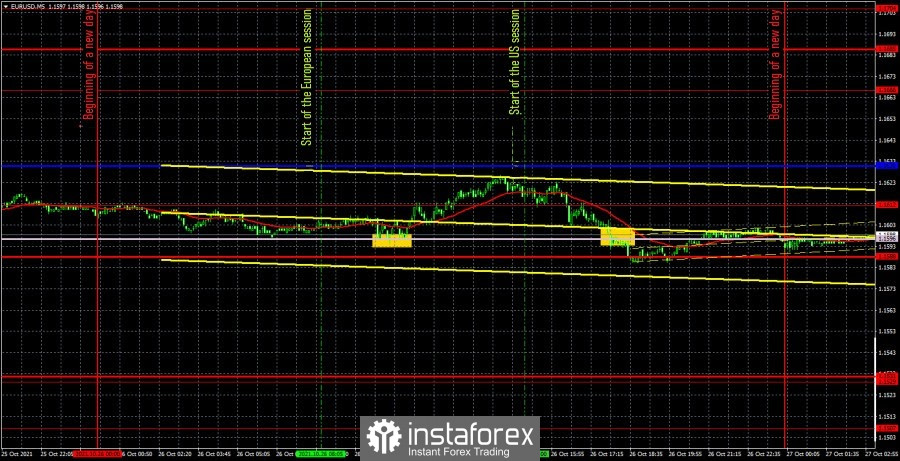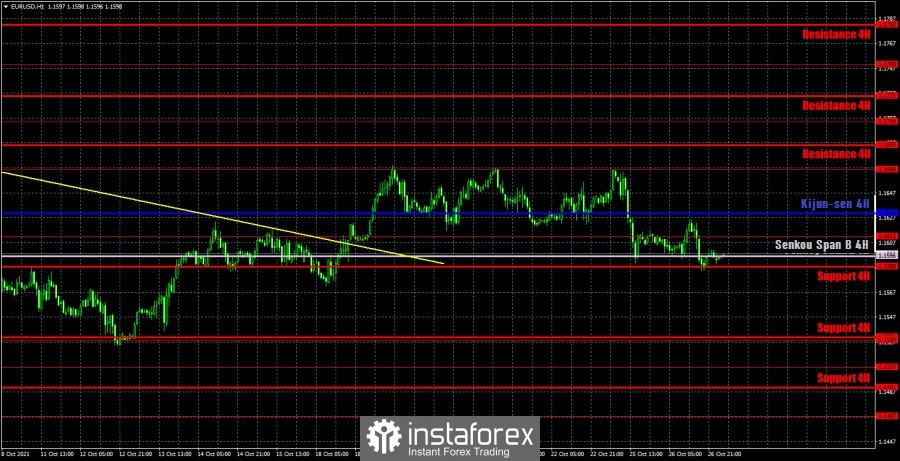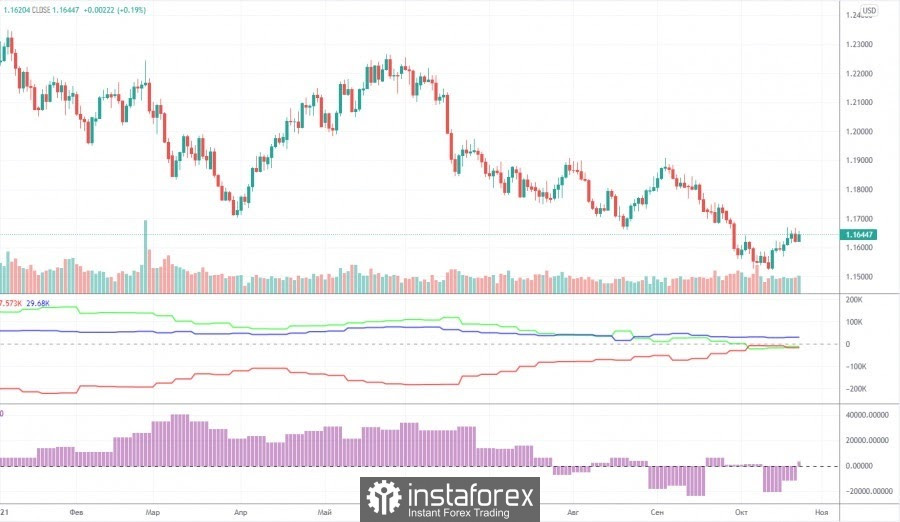EUR/USD 5M

The EUR/USD pair returned to its usual trading mode on Tuesday. Volatility was around 40 points again, and the movements took place in a limited horizontal range. To put it simply, first the euro rose in price by 30 points, and then fell by 40 points. No macroeconomic statistics were published either in the United States or in the European Union on Tuesday. Thus, the mid-day reversal of the pair cannot be associated with any report or fundamental event. The markets basically had nothing to react to during the day. Thus, the euro only occasionally tries to show a trend movement, but in four cases out of five it is trading in absolute flat and with low volatility. This can be seen especially well on the hourly timeframe or higher. Now let's look at the trading signals that were generated on Monday, although there is nothing special to consider here. In the latest reviews for the pound and the euro, we drew your attention to the fact that the Ichimoku indicator lines are not strong during a flat, so false signals can form around them. In reality, both this factor and the flat factor worked, when, in principle, false signals were formed. The first buy signal was formed at the beginning of the European session, when the price bounced off the Senkou Span B line. The movement after that was quite good, but it was not possible to reach the Kijun-sen line, so the deal was closed by Stop Loss, which should have been set at breakeven as the price went up 15 points. The next sell signal was formed almost in the evening, when the price settled below the Senkou Span B. However, it clearly should not have been worked out, since by that time it had already become clear that the pair was in a flat again.
EUR/USD 1H

The hourly timeframe also shows that the pair continues to move mostly sideways. Thus, the Ichimoku indicator lines are not strong now, and there is no trend, and the volatility is weak. An "ideal" situation for opening positions. However, nothing can be done about it. You need to work with what you have. Perhaps the situation will change today, when important statistics will be published in the United States, but, as practice shows, reports only have a local effect on the pair's movement. On Wednesday, we highlight the following levels for trading - 1.1529, 1.1612, 1.1666, as well as the Senkou Span B (1.1596) and Kijun-sen (1.1630) lines. The Ichimoku indicator lines can change their position during the day, which should be taken into account when looking for trading signals. Signals can be rebounds or breakthroughs of these levels and lines. Do not forget about placing a Stop Loss order at breakeven if the price moves 15 points in the right direction. This will protect you against possible losses if the signal turns out to be false. Also, do not forget that in a flat the Ichimoku indicator lines lose their strength, so they can even be ignored, especially the Kijun-sen line. Or work out only when there are really strong signals. A report on durable goods orders will be published in America on October 27. According to analysts, this indicator may decline by 1.1% m/m after + 1.8% in August. The markets are unlikely to be delighted with such information, but everything will depend on how much the forecast is exceeded or downgraded. We also note that this report can be easily and simply ignored by traders, as it is not overly important.
We recommend you to familiarize yourself:
Forecast and trading signals for GBP/USD for October 27. Detailed analysis of the movement of the pair and trade deals.
Analysis of the COT report

The mood of non-commercial traders changed into a bullish direction during the last reporting week (October 12-18). During the reporting week, 8,500 buy contracts (longs) and 16,000 sales contracts (shorts) were closed. Thus, the net position of the "non-commercial traders" group, which is the most important group, increased by 7.5 thousand. And here it is just right to talk about the "disease of the British pound." Let us remind you that the net position of professional pound players has been jumping up and down over the past few months. And this, in turn, indicates that there is no single mood and clear trend. We are seeing the same thing now in the euro currency. This is eloquently signaled by the second indicator, which shows either an increase in the net position or a decrease. Consequently, at this time, major players do not understand what to do next with the euro currency. Also, in the chart above, you can see that the pair rate went only 100 points below the previous local low. Therefore, at this time, the entire technical picture of the long-term plan still looks like a standard three-wave correction. Therefore, from our point of view, the formation of a new upward trend in the near future is still very likely, given the attempts with which the European currency has been falling over the past 8-9 months. But at the same time, we remind you that while there are no buy signals, you should not rush to the market with long positions. Any fundamental hypothesis requires specific technical confirmation. If they are not there, then you should not make the appropriate trading decisions.
Explanations for the chart:
Support and Resistance Levels are the levels that serve as targets when buying or selling the pair. You can place Take Profit near these levels.
Kijun-sen and Senkou Span B lines are lines of the Ichimoku indicator transferred to the hourly timeframe from the 4-hour one.
Support and resistance areas are areas from which the price has repeatedly rebounded off.
Yellow lines are trend lines, trend channels and any other technical patterns.
Indicator 1 on the COT charts is the size of the net position of each category of traders.
Indicator 2 on the COT charts is the size of the net position for the non-commercial group.
The material has been provided by InstaForex Company - www.instaforex.comfrom RobotFX















 Download NOW!
Download NOW!
No comments:
Post a Comment